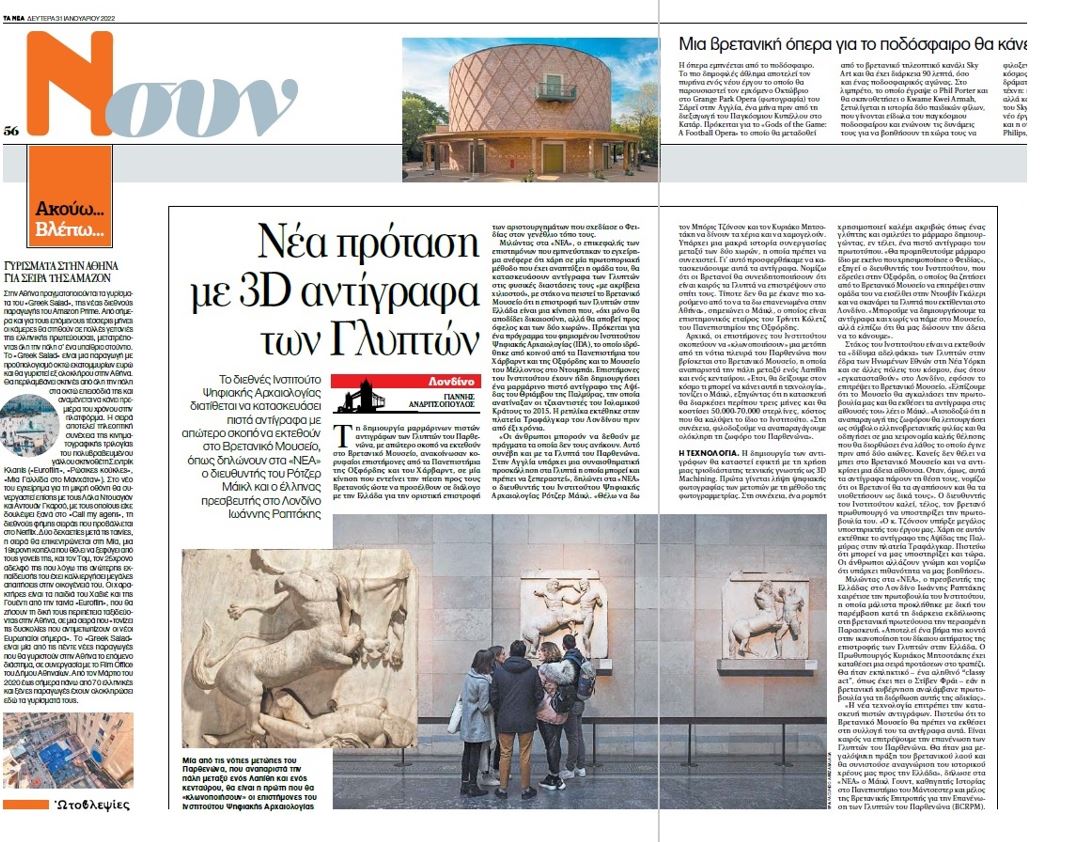Telegraph 29 January 2022
Technology that allows archaeologists to make a millimetre-perfect replica paves way for a deal with British Museum, says Greek ambassador. The plan to copy the section of the Parthenon frieze in the British Museum comes from the Institute for Digital Archaeology (IDA), which created a full-size replica of Syria’s Palmyra Arch which was blown up by Isis in October 2015.
To read this article in full, visit The Telegraph.
Ta Nea 31 January 2022
Yannis Andritsopoulos, UK correspondent for Ta Nea published an aricle on Monday:'New proposal for 3D copies of the Sculptures. The international Institute of Digital Archaeology is willing to make exact replicas with the ultimate goal of exhibiting them in the British Museum, as reported in ‘Ta Nea’ by the IDA’s director Roger Michel and the Greek Ambassador in London, Ioannis Raptakis.'
Speaking to ‘Ta Nea’ the head of the scientists who inspired the project explained that the innovative method developed by his team could create copies of the sculptures, which may convince the British Museum to return the fragment sculptures in Room 18 to Greece. A move that is "justifiable and will be of benefit to both countries."
"I want to see Boris Johnson and Kyriakos Mitsotakis shaking hands and smiling. There is a long history of cooperation between the two countries, which must continue. That's why we offered to make these copies. I think the British will realise that it is time for the Parthenon sculptures to return home. Nothing would make me happier than seeing them reunited in Athens," notes Roger Michel.
Initially, the Institute's scientists intend to "clone" a metope from the south side of the Parthenon located in the British Museum, which represents the struggle between a Lapithe and a centaur. "We're going to show people what this technology can do," Michel explains. This will take about three months and cost £50,000-70,000, a cost that the Institute itself will cover. "Then, we aspire to reproduce the entire parthenon frieze."
The Oxford-based institute has pioneered a technique known as 3D Machining. First a digital image is created using photogrammetry, then a robot-operated machine uses chisels in the same way as a human sculptor to carve a copy of the original.
"We will procure marble identical to the one used by Phidias," explains the director of the Oxford-based Institute, who will ask the British Museum to allow his team to scan the Sculptures on display in London.*
The aim of the Institute is to exhibit the entire Parthenon frieze at the United Nations headquarters in New York and other cities of the world, until they are "installed" in London, if the British Museum allows it. "We hope the Museum will embrace our initiative and exhibit the copies, to facilitate the reunification of the surviving pieces in Room 18 with those in the Acropolis Museum.
"I am optimistic that the reproduction of the frieze will act as a symbol of Greek-British friendship and will lead to a gesture of goodwill that will correct a mistake that was made two centuries ago."
The Director of the Institute calls on the British Prime Minister to support his initiative. "Mr Johnson has been a great supporter of our work. Thanks to him, the copy of the Arch of Palmyra in Trafalgar Square was exhibited. I believe he can support us now. People change their minds and I think there's a chance it will help this call for the reunification also."
Speaking to ‘Ta Nea’, Greece's Ambassador to London Ioannis Raptakiswelcomed the Institute's initiative, which was inspired by his own intervention during an event in the British capital last Friday. "It is one step closer to meeting the respectful request for the return of the Sculptures to Greece. Prime Minister Kyriakos Mitsotakishas put a number of proposals on the table. It would be amazing, if the British government were to take the initiative to correct this injustice."
"The new technology allows the manufacture of exact copies. I believe that the British Museum should present these copies in its collection. It is time to allow the reunification of the Parthenon Sculptures. It would be a magnanimous act of the British people and would be a recognition of our historic debt to Greece," Michael Wood, professor of history at the University of Manchester and member of the British Committee for the Reunification of the Parthenon Sculptures (BCRPM), told ‘Ta Nea’.
To read the original article in Greek, follow the link to Ta Nea.

* In 2012, the BM gave Niall McLaughlin Architects permission to scan the frieze in Room 18